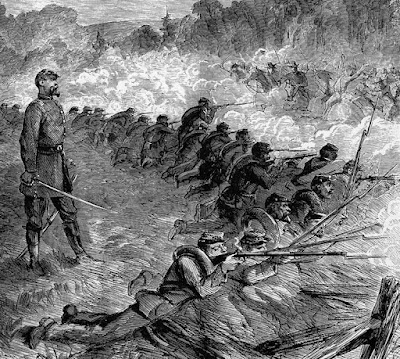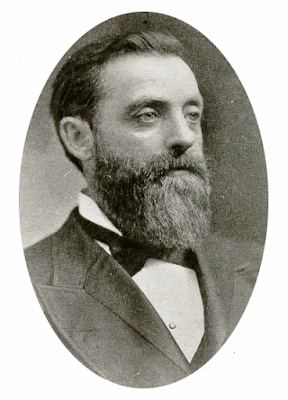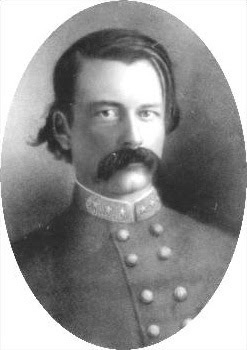They Rode Into Our Works: With Casement’s Brigade at Franklin
Positioned in the left center of the Federal line at the Battle of Franklin, Colonel John Casement's brigade bore some of the heaviest attacks of the engagement. Captain James S. Putnam, serving on Colonel Casement's staff as acting assistant adjutant general, wrote three letters home to his wife in Illinois describing his experiences.
"The enemy formed under cover of a wood and advanced in columns driving in our front line without firing," he wrote. "As soon as they had all got inside our works and when the enemy was within 200 yards, we opened a murderous fire of musketry, grape, and canister that from the batteries plowed at various points along the lines. Still, they continued to advance till in many places they actually reached our works. At the 23rd Indiana Battery, they came right into the embrasures and were knocked down by the men with the spikes of the guns. The 104th Ohio, a regiment of the First Brigade placed on our right, gave way at one time and for a moment things looked a little dubious, but in the next moment two fresh regiments were sent into the line thus left vacant and the advance of the enemy was soon checked. But they would rally and come again under such a fire as it seemed no single man could find a place to stand in and not get killed."
Captain Putnam’s accounts first sawpublication in the December 10, 1864, and December 24, 1864, editions of the WaukeganWeekly Gazette.
 "The 23rd Corps withstood the long, continued, most persistent, and furious attack of two corps of the Rebels led on by officers of unequalled daring and bravery who rode on to our works," Captain James Putnam of the 65th Illinois observed. "They were shot down by our pistols, their men following them and their brains beaten out with our muskets."
"The 23rd Corps withstood the long, continued, most persistent, and furious attack of two corps of the Rebels led on by officers of unequalled daring and bravery who rode on to our works," Captain James Putnam of the 65th Illinois observed. "They were shot down by our pistols, their men following them and their brains beaten out with our muskets." Camp ofSecond Brigade, Nashville, Tennessee
December 1,1864
Dear wife,
I am most happy to be able to writeyou at this time for I know the newspaper reports of our battle yesterday willvery naturally cause you unusual anxiety on my behalf. We fought yesterday oneof the most bloody and, on the part of the enemy, one of the most desperate andterrible battles the history of this cruel and wicked rebellion has yetfurnished.
We had retired from Columbia the night before and wereclosely followed by the enemy who in that act probably greatly erred in hisestimate of the strength of our works of defense which we constructed in thespace of three hours time. These were, nevertheless, quite formidable and itwas reserved for the 23rd Army Corps then and there to make its markand win a proud and enduring fame. We were supported by the First and ThirdDivision of the 4th Corps while the Second and Third Divisions ofthe 23rd Corps withstood the long, continued, most persistent andfurious attack of two corps of the Rebels, led on by officers of unequalleddaring and bravery who rode on to our works. They were shot down by ourpistols, their men following them and their brains beaten out with our muskets.
Colonel W. Scott Stewart [65th Illinois] captured one battle flag, one brigadiergeneral, and one colonel besides a number of subordinate officers and 100 men.We captured altogether some 1,500 prisoners and left 4,000-6,000 Rebel killedand wounded on the field. The roar of the artillery and the rattle of musketrywas grand and terrible and terribly destructive to the Rebels as they advancedin columns on our works. Our losses are very light; indeed, no one was hurt inthe 65th Illinois although it suffered a loss of 29 men two daysbefore in a skirmish. I had many narrow escapes but am most thankful that mylife was spared to be able to communicate again with you.
Under the cover of the night we removed to this city and itis my opinion that we have so great a loss and moral defeat upon the enemy thatany attack upon this place is altogether improbable. We have more than doublethe force here with which we fought yesterday and the result, if a battle isfought here, cannot be doubtful.
 Colonel John S. Casement served as major of the 7th Ohio Infantry for about a year before accepting promotion to lead the 103rd Ohio in August 1862. His brigade, consisting of the 65th Illinois, 65th Indiana, 124th Indiana, 103rd Ohio, and 5th Tennessee, held position near the Federal center at the Battle of Franklin.
Colonel John S. Casement served as major of the 7th Ohio Infantry for about a year before accepting promotion to lead the 103rd Ohio in August 1862. His brigade, consisting of the 65th Illinois, 65th Indiana, 124th Indiana, 103rd Ohio, and 5th Tennessee, held position near the Federal center at the Battle of Franklin. Headquarters,Second Brigade, Nashville, Tennessee
December 4,1864
Dear wife,
In reference to the operations of theenemy, there is nothing particularly new. In an attempt to lay a pontoon bridgelast night, they were badly defeated and a considerable number of them werecaptured and their pontoon boats between the city and the gunboats below weredestroyed.
I will now tell you a little moreabout the Battle of Franklin. Our lines were in the form of a horseshoe fromthe river above to the river again below the town and the lines of the enemywere formed entirely around or outside of ours, connecting the same points andabout half a mile in front of us. The enemy formed under cover of a wood andadvanced in columns driving in our front line without firing. As soon as theyhad all got inside our works and when the enemy was within 200 yards, we openeda murderous fire of musketry, grape, and canister that from the batteriesplowed at various points along the lines.
Still, they continued to advance till in many places theyactually reached our works. At the 23rd Indiana Battery, they cameright into the embrasures and were knocked down by the men with the spikes ofthe guns. The 104th Ohio, a regiment of the First Brigade placed onour right, gave way at one time and for a moment things looked a littledubious, but in the next moment two fresh regiments were sent into the linethus left vacant and the advance of the enemy was soon checked. But they wouldrally and come again under such a fire as it seemed no single man could find aplace to stand in and not get killed.
Thus, they continued charge after charge till they were socompletely shattered, routed, and broken up that they could no longer preservean organization. Then they all fled in precipitate rout. Their losses areestimated at 4,500-5,000 men; of these, 1,800 are prisoners including twogenerals and about 130 other officers. I passed over the field after dark andthe dead and wounded covered the ground. Our losses are not more than 300-400and these are mostly slightly wounded.
After the battle, we crossed the railroad bridge and came onto Nashville, the enemy not following us very closely. Our division bore thebrunt of the attack and done it nobly, too. A small portion of the SecondDivision was on the left, the rest being in position on the other side of theriver while the 4th Corps was mostly there, too, only a part of ourdivision being on the right of our line. We only hope Mr. Hood will repeat hisrashness here and I think we can make an end of his army.
 Brigadier General John Adams was struck down upon the line of works held by Casement's brigade.
Brigadier General John Adams was struck down upon the line of works held by Casement's brigade. Camp on thedefenses of Nashville, Tennessee
December 13,1864
(To theeditors of the Waukegan Weekly Gazette)
Friend Cory,
Since I wrote you last, on the 30thultimo we encountered the forces of the enemy at Franklin. This village is locatedon the Little Harpeth, a stream of no considerable dimensions over which atthis point the only crossing in on the railroad bridge. It is about 18 milesdistant from this city. Our lines were formed to cover and protect the crossingof the trains extending from Harpeth above to the Harpeth below the town. Theywere protected by a slight trench and breastwork of earth under which our braveboys anxiously awaiting the approach of the enemy while the long line of wagontrains were rapidly and in good order hurried over the bridge and hurried alongtowards this city.
Our cavalry covered the flanks thussecuring us against the possible flank movement of the enemy by crossing theriver above or below us. Skirmishing ensued early in the afternoon with theenemy’s cavalry and at precisely 4 p.m., his infantry appeared advancing incolumn. The ground in our front for a mile and a half was an undulating plainon all parts of which the movements of the enemy could be distinctly seen. Ourforces, the 4th and 23rd Corps, numbered about 25,000effective men while the three corps of the enemy (Cheatham, Stewart, and Lee)were by their own reports at least 34,000 strong.
The Rebel leader had ordered a charge. His men were brave,the officers desperate, and never did bravery and desperation continue in amore persistent and determined assault. From 4-8 o’clock, four mortal hours,did these doomed men continue in charge after charge to hurl themselves withthe irresistible fury of an avalanche upon our unyielding lines of steel andlead and iron hail. With their stars and bars planted on our parapets, thecolor bearers fell in the ditch. With their hands on the very guns of ourrifled batteries, their brains were dashed out with the hand spikes of thoseguns. They rushed upon our lines with foolhardy and frenzied desperation andthey were hurled from them in the most sanguinary, utter, and indescribable destruction.
At 8 o’clock, the battle was substantially over thoughskirmishing of a lively sort continued until after 10 p.m. At this time, ourfront lines were again advanced and we thus occupied the field of blood. Asight (or rather sounds for darkness covered the scene from view) was therewhich I hope never to encounter again. The mangled, dead, and wounded bodies ofmore than 6,000 rebels filled the ditches and covered the limited plain infront of our lines.
The Rebel General Patrick Cleburne was killed by a shell atthe very outset. Brigadier General John Adams fell in front of the gallant, veteran65th Illinois and his personal effects were collected and sent byflag of truce to his friends in the Rebel lines. Colonel William Scott Stewartwas allowed to retain Adams’ pistol as being contraband of war. Colonel Stewartalso captured a Colonel Stephens [Colonel Marcus D.L. Stephens, 31stMississippi?] with several other officers and a considerable number ofprisoners, arms, etc. The noble little Second Brigade stood firm as a rock fromfirst to last; not a man left the lines with gallantry rarely equaled andunsurpassable. Its commanding officer, Colonel John S. Casement, on seeing thelines of an adjoining brigade waver and almost break, quickly moved to the spotand by the example of his own startling energy, courage, and bravery, soonrestored the order and solidity of the lines and prevented a complete breachwhich might have proved fatal to the fortunes of the day.
General Cox, also, was in the thickest of the fight, calm andcollected as if on parade, he directed the movements of the 23rdCorps to the admiration of all, both officers and men. General Stanley,commanding the 4th Corps, is mentioned in the highest terms ofpraise and General Schofield, in a position where he could view all themovements on the field, was the master spirit, directing the whole. The losseson our part are considerable, though small when compared to those of the enemy.
In the 65th Illinois, thecasualties are but few owing chiefly to the good cover afforded by our works.And it gives me great pleasure to add that our Lake County boys, every one,escaped unhurt. The whole army did its duty bravely, nobly, well. Under coverof the night, General Schofield retired to the position we now occupy. HereHood again confronts us, but he keeps at a very respectable distance andappears to be in no hurry to repeat the Franklin tactics.
Our forces have been augmentedsomewhat since reaching this point and all are now hopeful, confident, naydefiant. “Let Hood come and the sooner the better,” say the boys. And so sayall of us, let him come. Weather very wintry the past three days as snow andice abound. More as time permits.
Very trulyyours,
James S.Putnam
Captain, 65thIllinois Vols, A.A.G., Second Brigade, Third Division, 23rd ArmyCorps
To learn more about the Battle of Franklin, please check out the following posts:
10 Days to Franklin: The 183rd Ohio Goes to WarA Buckeye Surgeon Behind the Lines at Franklin (118th OVI)Awful Scenes of Carnage: A Buckeye Recalls Franklin (26th OVI)Awful to the Extreme: Voice from the 125th Ohio at FranklinAt the Center of Hell: The 100th Ohio at Franklin Fighting with Axes, Picks, and Sponges with the 6th Ohio BatteryPandemonium Reigned Supreme: A Buckeye Captured at FranklinVignettes of the Battle of FranklinFirm as an Iron Pillar: A Hoosier Describes the Battle of Franklin (129th Indiana)The Horrors of War on All Hands: The "Fighting Parson" of the 79th Illinois Recalls FranklinHold the Bridge at All Hazards: The Last Stand on the Duck River at Columbia (22nd Indiana Battery)Source:
Letters fromCaptain James S. Putnam, Co. F, 65th Illinois Volunteer Infantry (ondetached duty as Assistant Adjutant General on Colonel John S. Casement’sbrigade staff), Waukegan Weekly Gazette (Illinois), December 10, 1864,pg. 3; also, December 24, 1864, pg. 2
Daniel A. Masters's Blog
- Daniel A. Masters's profile
- 1 follower



